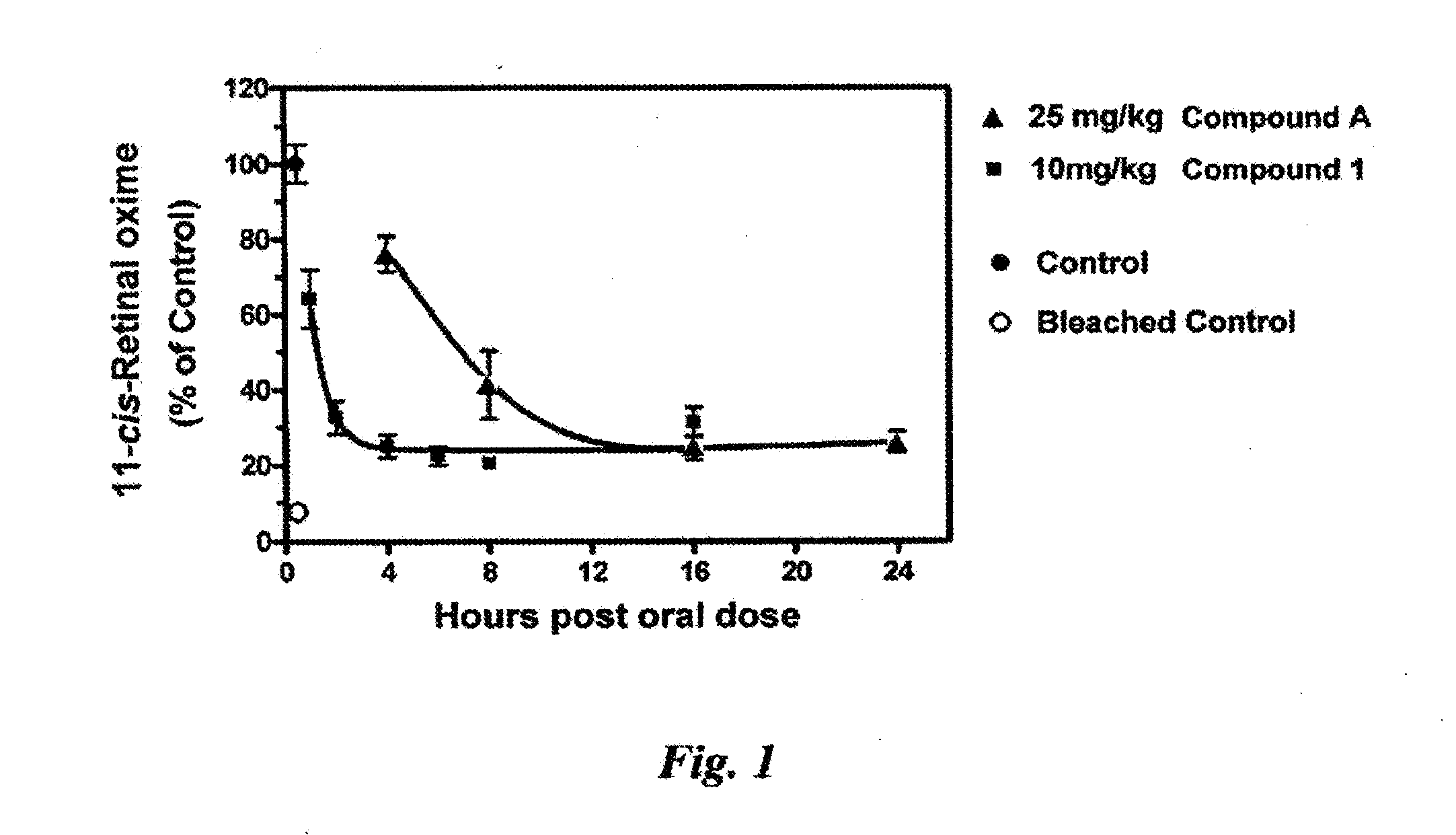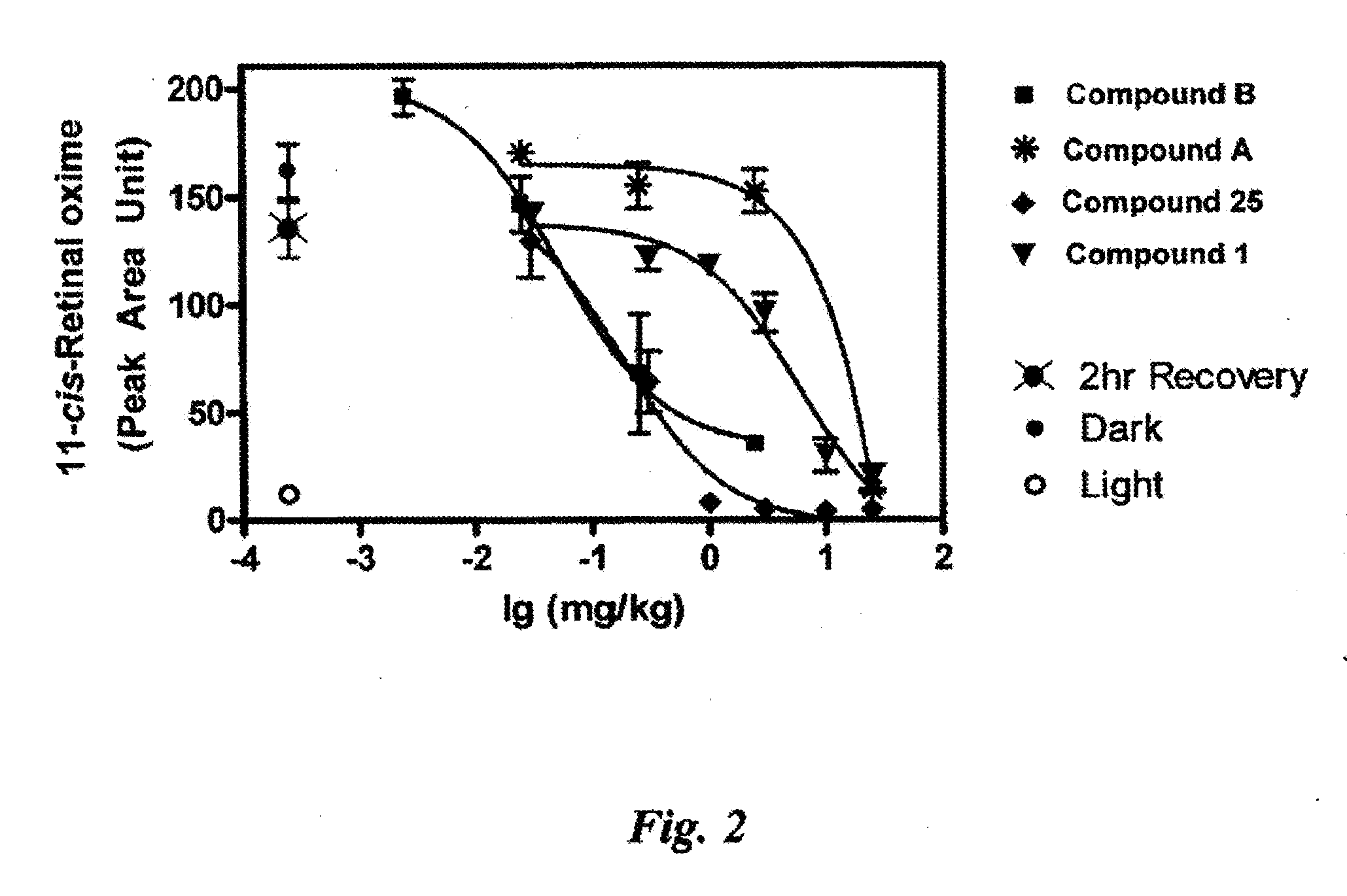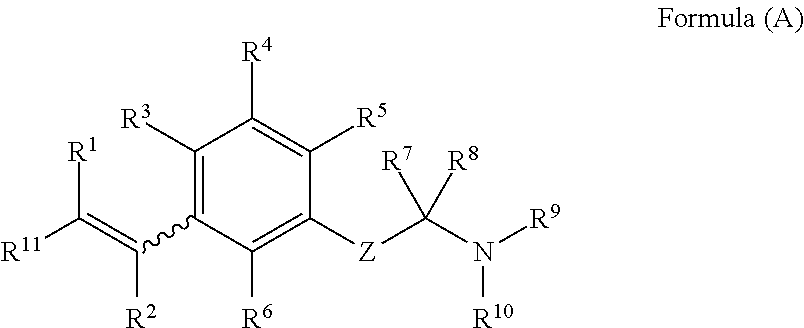Styrenyl derivative compounds for treating ophthalmic diseases and disorders
a technology of ophthalmic diseases and derivative compounds, applied in the direction of biocide, cardiovascular disorders, drug compositions, etc., can solve the problems of blindness in the central vision, damage to the overlying retina, and blindness in aging populations worldwide, so as to reduce the ischemia of the eye
- Summary
- Abstract
- Description
- Claims
- Application Information
AI Technical Summary
Benefits of technology
Problems solved by technology
Method used
Image
Examples
example 1
Preparation of (E)-3-(3-(2,6-dimethylstyryl)phenyl)propan-1-amine
[0891]
[0892](E)-3-(3-(2,6-dimethylstyryl)phenyl)propan-1-amine was prepared following the method described in Scheme 1. (See, Also, Methods A and J)
[0893]Step 1: To a stirred solution of 2,6-dimethylbenzoic acid (1) (10.0 g, 66.6 mmol) in THF (100 mL) at 0° C. was added borane-THF complex (80 mL, 1M solution in THF, 80.0 mmol) dropwise over 20 min and then the reaction mixture was warmed to room temperature. After 64 h the reaction mixture was quenched by slow addition of methanol (70 mL) and the resulting solution concentrated. The residue was suspended in ethyl acetate (300 mL) and washed with water (4×50 mL) and brine (50 mL), and the organic layer was dried (Na2SO4), filtered and concentrated. The residue was dried in vacuo to give 2 (9.10 g, >99%) as a white solid: 1H NMR (500 MHz, CDCl3) δ 7.13-7.03 (m, 3H), 4.74 (d, J=5.1 Hz, 2H), 2.43 (s, 6H), 1.28 (t, J=5.2 Hz, 1H); ESI MS m / z 119 [M+H—H2O]+.
[0894]Step 2: To a...
example 2
Preparation of (Z)-3-(3-(2,6-dimethylstyryl)phenyl)propan-1-amine
[0902]
[0903](Z)-3-(3-(2,6-dimethylstyryl)phenyl)propan-1-amine was prepared following the method used in Example 1.
[0904]Step 1: (Z)-3-(3-(2,6-Dimethylstyryl)phenyl)propanal was prepared following the method described in Example 1. Purification by column chromatography (silica, 0-20% ethyl acetate / hexanes) gave (0.054 g, 26%) of a yellow oil: Rf 0.56 (silica gel, 90:10 methylene chloride / 7N ammonia in methanol); 1H NMR (500 MHz, CD3OD) S 1H NMR (500 MHz, CDCl3) δ 9.67 (t, J=1.3 Hz, 1H), 7.10 (q, J=7.7 Hz, 2H), 7.06-7.03 (m, 2H), 6.95 (d, J=7.6 Hz, 1H), 6.85 (d, J=7.8 Hz, 1H), 6.76 (s, 1H), 6.62 (d, J=12.2 Hz, 1H), 6.54 (d, J=12.2 Hz, 1H), 2.75 (t, J=7.6 Hz, 2H), 2.53-2.50 (m, 2H), 2.14 (s, 6H); ESI MS m / z 247 [M+H—H2O]+.
[0905]Step 2: Reductive amination of (Z)-3-(3-(2,6-Dimethylstyryl)phenyl)propanal with ammonia following the method described in Example 1 followed by purification by column chromatography (silica, 99:1...
example 3
Preparation of (E)-4-(3-(3-(2,6-dimethylstyryl)phenyl)propyl)morpholine
[0906]
[0907](E)-4-(3-(3-(2,6-Dimethylstyryl)phenyl)propyl)morpholine was prepared following the method described in Scheme 2.
[0908]Step 1: To a stirred solution of 3-bromobenzaldehyde (7) (3.70 g, 20.0 mmol), acrolein diethyl acetal (7.81 g, 60.0 mmol) and tributylamine (7.41 g, 40.0 mmol) in DMF (40 mL) was added tetrabutylammonium chloride (5.56 g, 20.0 mmol) followed by palladium(II) acetate (0.135 g, 0.601 mmol) and the reaction mixture was heated at 90° C. After 27 h the reaction mixture was cooled to room temperature, diluted with 2N hydrochloric acid (20 mL), and extracted with a 1:1 mixture of diethyl ether and hexanes (3×150 mL), the combined extracts were washed with water (3×100 mL), dried (Na2SO4), filtered and concentrated. The resulting residue was purified by flash column chromatography (silica gel, 90:10 hexanes / ethyl acetate) to give 8 (2.97 g, 72%) as a light yellow oil: 1H NMR (500 MHz, CDCl3) ...
PUM
| Property | Measurement | Unit |
|---|---|---|
| structure | aaaaa | aaaaa |
| temperature | aaaaa | aaaaa |
| pharmaceutical composition | aaaaa | aaaaa |
Abstract
Description
Claims
Application Information
 Login to View More
Login to View More - R&D
- Intellectual Property
- Life Sciences
- Materials
- Tech Scout
- Unparalleled Data Quality
- Higher Quality Content
- 60% Fewer Hallucinations
Browse by: Latest US Patents, China's latest patents, Technical Efficacy Thesaurus, Application Domain, Technology Topic, Popular Technical Reports.
© 2025 PatSnap. All rights reserved.Legal|Privacy policy|Modern Slavery Act Transparency Statement|Sitemap|About US| Contact US: help@patsnap.com



